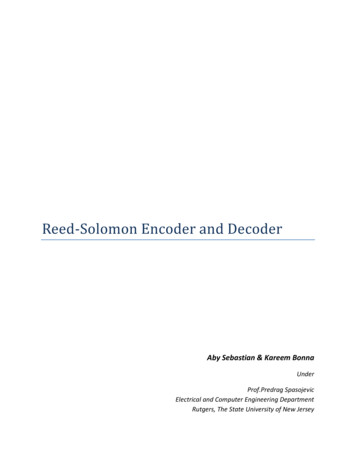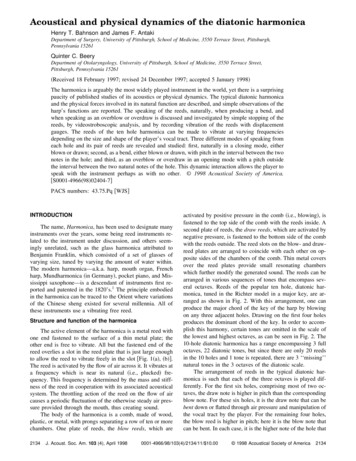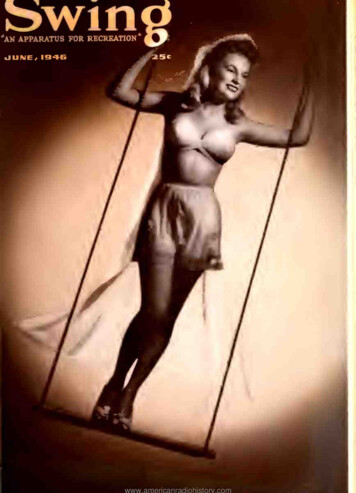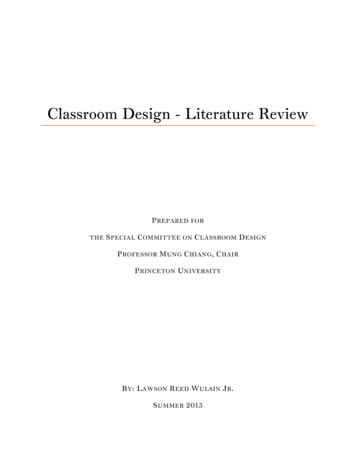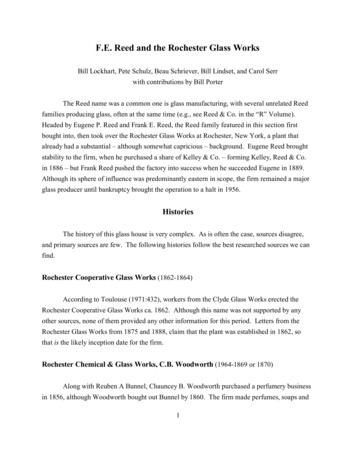
Transcription
F.E. Reed and the Rochester Glass WorksBill Lockhart, Pete Schulz, Beau Schriever, Bill Lindset, and Carol Serrwith contributions by Bill PorterThe Reed name was a common one is glass manufacturing, with several unrelated Reedfamilies producing glass, often at the same time (e.g., see Reed & Co. in the “R” Volume).Headed by Eugene P. Reed and Frank E. Reed, the Reed family featured in this section firstbought into, then took over the Rochester Glass Works at Rochester, New York, a plant thatalready had a substantial – although somewhat capricious – background. Eugene Reed broughtstability to the firm, when he purchased a share of Kelley & Co. – forming Kelley, Reed & Co.in 1886 – but Frank Reed pushed the factory into success when he succeeded Eugene in 1889.Although its sphere of influence was predominantly eastern in scope, the firm remained a majorglass producer until bankruptcy brought the operation to a halt in 1956.HistoriesThe history of this glass house is very complex. As is often the case, sources disagree,and primary sources are few. The following histories follow the best researched sources we canfind.Rochester Cooperative Glass Works (1862-1864)According to Toulouse (1971:432), workers from the Clyde Glass Works erected theRochester Cooperative Glass Works ca. 1862. Although this name was not supported by anyother sources, none of them provided any other information for this period. Letters from theRochester Glass Works from 1875 and 1888, claim that the plant was established in 1862, sothat is the likely inception date for the firm.Rochester Chemical & Glass Works, C.B. Woodworth (1964-1869 or 1870)Along with Reuben A Bunnel, Chauncey B. Woodworth purchased a perfumery businessin 1856, although Woodworth bought out Bunnel by 1860. The firm made perfumes, soaps and1
toilet articles. Woodworth gained control of the glass plant – located at 178 Plymouth Ave. inRochester – by 1864 and changed the factory name, probably to the Rochester Chemical & GlassWorks. When the operating company became C.B. Woodworth & Son in 1868, the glass plantwas certainly known by the Rochester Chemical & Glass Works name. Woodworth sold theglass factory in 1869 or 1870 to concentrate on perfume (Collecting Vintage Compacts 2014;Roller 1997).Containers and MarksTHE MODEL JAR (ca. 1867-1870 or later)Roller (1983:254) noted twovariations of THE MODEL JAR, bothmouth-blown (Figure 1). One wasembossed “THE MODEL JAR (arch) /PATD / AUG. 27. 1867 (both horizontal)”;the other added “ROCHESTER, N.Y.”Figure 1 – Finish of ModelJar (North American Glass)below the date (Figures 2 & 3). Thecardboard cap cover stated “THE MODELJAR PATENTED AUG. 27 1867 (eagleFigure 2 – Model Jar(North American Glass)figure) J.J. VAN ZANDT PROPRIETOR &MANUFACTURER, ROCHESTER, N.Y.” (Figure 4). He added that“J.J. Van Zandt was listed as a coffee and spice merchant in the 1860sRochester city directories. These jars are found with two distinctlydifferent finishes”(Figure 5) Inaddition, thenumerals (27,1867) on onevariation were in aFigure 3 – Model JarRochester (NorthAmerican Glass)“fancy style”(Figure 6). Hesuggested theFigure 4 – Van Zandt cap (North American Glass)2
Rochester Glass Works as the probable maker.The update (Roller 2010:379) filled in theinformation from Creswick (below).Creswick (1987:159) illustrated both jarsand added that Charles F. Spencer receivedFigure 5 – Two finishes (North American Glass)Figure 6 – Label variation (North American Glass)Patent No. 68,319 on August 27, 1867 (Figure 7).The cardboard cover, of course, is very rare.Echoing Roller, she pointed out that the two jars“have slightly different necks but use the samesealing method.” Van Zandt was a dealer in coffee,tea, and spices, beginning in 1844 and remained inbusiness until he retired, being succeeded by hisbrothers, Benjamin and Macy Van Zant. Creswickwas more certain that the Rochester Glass WorksFigure 7 – Spencer 1857 patentmade the jars ca. 1867.WHITMORE’S PATENT (ca. 1868-early 1870s)Toulouse (1969:329) described a mouth-blown fruit jar with a “notched glass lid andspring wire bail” embossed “WHITMORE’S (arch ) / PATENT (horizontal with a reversed “N”)/ ROCHESTER (arch) / N.Y. (horizontal)” on the side. He suggested the Rochester Glass Worksas the probable manufacturer ca. 1868. The lid was embossed “PATENTED JAN’Y 14TH 68.”He noted that he could not locate the patent – although North American Glass illustratedexamples with an “L” or a reversed “P” above the numbers (Figure 8).3
Roller(1983:381-382)described the lid asa “finned glass lidheld down bylowed-wire bailFigure 8 – Whitmore lids (North American Glass)hooking into bosseson jar neck” (Figure9) The patent holder,Enos B. Whitmore,was listed inRochester citydirectories from 1855to 1878. Roller notedthe variation with theFigure 9 – Whitmore bails (North American Glass)reversed “N” and onewith the “N” innormal aspect (Figure 10). A variation had a“compass & square design embossed on thebase,” and another jar was embossed“WHITMORE’S PATENT” above “tworectangular areas of mold alteration” that mayhave covered “JAN 14TH 1868” (Figure 11).Figure 10 – Whitmorejar (North AmericanGlass)He noted that the jars were “not made byaltering a regular Whitmore jar mold.” The dimensions of the jar wereslightly different, and the bails were not interchangeable.Creswick (1987:221) illustrated three variations, including thecompass & square, the one with the reversed “N,” and one with therectangular blocked-out area (Figure 12). She noted that Enos B.Whitmore received Patent No. 73,271 on January 14, 1868 (Figure 13).Figure 11 – Whitmorevariation (NorthAmerican Glass)She dated all three jars ca. 1868 and claimed the Rochester GlassWorks as the maker.4
The Roller update (2011:551) cited atrade card and a letter dated July 22, 1869, totrace theancestry ofthe jars.Foster &Whitmore,77 & 79Figure 12 – Whitmore jars (Creswick 1987:221)Exchange St.,Rochester,listed themselves as “Proprietors and Manufacturers of TheWhitmore Patent Fruit Jar,” and E.G. Whitmore and G.H.Foster were actually the vendors of the jars. Although Rollercalled the maker “uncertain,” he said it was “probably” madeby the Rochester Glass Works. By at least July 22, 1869,Boughton & Powell had become distributors of the jars. Boththe letterhead and the trade card illustrated the same jar –Figure 13 – Whitmore 1868 patentobviously the same patent.Rochester Glass Works, Thomas A. Evans (ca. 1870-ca. 1873)Thomas A. Evans, better known for his glass factory in Pittsburgh, became the proprietorof the Rochester Glass Works by 1870 – possibly a year earlier. Evans built the Mastodon glassfactory at Pittsburgh in 1855 and sold the plant to William McCully in 1869 (Hawkins 2009:195196). See the Other T section for more on T.A. Evans. Although surviving records from theperiod are spotty, he apparently then moved to Rochester and acquired the glass works there.We know that Evans still ran the plant in 1871, but the next evidence – a letterhead from 1875 –showed N.B. Gatchell & Co. as the operating firm (Roller 1997). We have been unable to traceEvans after 1871.5
Containers and MarksT.A. EVANS ROCHESTER (ca. 1870-ca. 1872)An eBay auctionoffered a colorless flaskembossed “T.A. EVANS /MANUFCTR / ROCHESTERNY” horizontally across theFigure 14 – T.A. Evans (eBay)base (Figures 14 & 15).Evans owned the RochesterGlass Works from ca. 1870 to some point between 1871 and 1875.Figure 15 – Evans flask(eBay)See the section for a company history.Rochester Glass Works, N.B. Gatchell & Co. (ca. 1873-1877)Roller (1997) described an 1875 ad for “N.B. Gatchell & Co., proprietors of theRochester Glass Works, mfrs. of glass bottles, flasks, &c., 178 Plymouth Ave.” The 1877 citydirectory says that Nathan B. Gatchell was “removed from city”1 – almost certainly marking theend of his tenure as proprietor (Roller 1997; von Mechow 2015).In April of 1862, James, Gatchell & Co. (F.H. James & N.B. Gatchell) had purchased theLancaster Glass Works, Lancaster, New York, at an assignee’s sale. The business became James& Gatchell in mid-1864, and that firm controlled the plant until 1873 (von Mechow 2015).Since Gatchell left Lancaster in 1873, that may indicate the year he obtained the Rochester GlassWorks. See section on Lancaster Glass Works for more information on that plant.1Although the specific meaning of “removed from city” is unclear, it seems to imply anegative connotation. There is almost certainly an interesting story behind this, although wefound nothing in a newspaper search. Gatchell apparently left town. When George Clarkassigned part of a British patent (No. 192,635) for an “apparatus for refining and aging alcoholicliquors” to several people, N.B. Gatchell or Lancaster, New York, was one of them. The patentwas received on November 2, 1877 (Great Britain Patent Office 1878).6
Rochester Glass Works, Kelley & Co. (at least 1881-1885)By 1881, Henry T. Kelley (Kelley & Co.) had gained control of the firm, althoughKelley’s tenure may have begun with the removal of Gatchell in 1877. Kelley & Co. operatedthe factory until at least July 8, 1885, when a billhead noted that the firm was “Manufacturers ofBottles.” The address of the plant was 178 Plymouth Ave. with “178” crossed out and “380”written in by hand (Roller 1997). This suggests that the numbering system had recently changedrather than a new location for the plant.Containers and MarksROCHESTER GLASS WKS. or WORKS (1882-ca. 1897)We have observed variationsof this mark on a flask and beerbottle offered for sale on eBay. Theyare obviously from the RochesterGlass Works. One beer base,illustrated in an out-of-focus photoFigure 16 – Glass Works /Rochester (eBay)Figure 17 – Rochester GlassWks (eBay)on eBay, was embossed “GLASSWORKS / ROCHESTER (both arches) / N.Y. / U.S.A. (both invertedarches)” on the base (Figure 16). The bottle had a Baltimore loop orblob finish and was almost certainly mouth blown. A flask offered on eBay was marked“ROCHESTER (slight arch) / GLASS WKS. (slight inverted arch)” on the base (Figure 17).Von Mechow (2015) described 12 beer bottles with variations of the Rochester logo ontheir bases. The vast majority of these were used by used by brewers in western New York,although one was as far east as Manchester, New Hampshire:1. “GLASS WORKS (arch) / ROCHESTER, N.Y. (inverted arch)” [8 examples]2. “GLASS WORKS (arch) / ROCHESTER (horizontal) / N.Y. (inverted arch)” [1 example]3. “GLASS WORKS (arch) / PAT 85 (horizontal) / ROCHESTER, N.Y. (inverted arch)” [2examples]7
4. “GLASS WORKS / ROCHESTER / PAT (all arches) / 85 / N.Y. / U.S.A. (all inverted arches)[1 example]The Baltimore Loop seal was patented in 1885, and bottles with the patent date embossedon the base were probably only made during the first few years. The vast majority of beerbottles with Baltimore Loop seals lack the patent date. Thus, the mark was probably used duringthe ca. 1885-1890 period.Rochester Glass Works marks are relatively rare. Searches on eBay for well over a yearhave only turned up two examples, and von Mechow is the only other sources we have foundthat displayed them. The types of bottles associated with the mark were typically manufacturedduring the ca. 1880-ca. 1900 period, although they could have been made somewhat earlier orlater. The 1885 patent date makes the most likely operating companies associated withRochester Glass Co. marks either Kelley & Co. (1881-1885) or Kelley, Reed & Co. (1886-1888),although the marks could have been used somewhat earlier by N.B. Gatchell. Since E.P. Reed &Co. began using a distinctive mark during the 1888-1889 period, the likely cutoff date for thelogo is 1887. Dating, however, is somewhat tenuous, as this name for the factory (as opposed tothe operating company) was used from as early as 1864 until well into the 20th century.Rochester Glass Works, Kelley, Reed & Co. (1886-1888)Around 1886, Eugene P. Reed bought into the business, and the firm became Kelly, Reed& Co. Reed had probably been associated with Kelly earlier. According to Toulouse(1971:433), “soon [after 1865], Eugene B. Reed, from Rochester, was employed as bookkeeper.As time went on Reed invested money in the business, and together with a Mr. Kelley, finallytook it over as ‘Kelley, Reed & Co.’” The firm was short-lived. When Kelley died in 1888,Reed gained control of the entire business (Dairy Antiques 2015; Creswick 1987a; Toulouse1971:432). We have discovered no distinctive mark used by this firm, although it may havecontinued the Rochester Glass Works logo – or used none.8
Rochester Glass Works, E.P. Reed & Co. (1888-1889)Upon Kelley’s death, Reed gained control, and the company became E.P. Reed & Co.An E.P. Reed & Co. billhead showed that Eugene P. Reed operated the glass works by at leastOctober 8, 1888, still at 380 Plymouth Ave. A letterhead from January 16, 1890, noted that F.E.Reed & Co. was the successor to E.P Reed & Co. It is likely that Frank E. Reed took over thefirm in late 1889. The city directories erroneously continued to list E.P. Reed & Co. until 1894,but Eugene Reed died on August 16, 1894 (Creswick 1987:276; Dairy Antiques 2015; Roller1997; Toulouse 1971:432-434; von Mechow 2015).Containers and MarksE.P. REED & Co.Von Mechow (2015) illustrated bottles with variations of an“E.P. REED & Co.” basemark that he found on three beer bottles(Figure 18):1. “E.P. REED & CO. (arch) / PAT 85 (horizontal) / ROCHESTER,N.Y. (inverted arch)”2. “E.P. REED & CO. (arch) / ROCHESTER (horizontal) / N.Y.(inverted arch)”Figure 18 – E.P. Reed&Co. (Von Mechow2015)One bottle was used by a brewer in Brooklyn, but the other two were in or close toRochester. We have not discovered a photo of this mark, but it was likely used only during thetwo years (1888-1889) when E.P. Reed & Co. was in business.F.E. Reed (1889-ca. 1903)Eugene P. Reed apparently retired from the business in 1889, and his brother, Frank E.Reed took over. By this point, there seems to have been a stronger identification with theoperating firm than with the factory name (Rochester Glass Works). A January 16, 1890,letterhead noted that F.E. Reed was the successor to E.P. Reed & Co., and city directories9
identified F.E. Reed as operating the glass works at 380 Plymouth Ave. from 1890 to 1902. By1897, the plant had two continuous tanks with ten rings. The factory was listed with 10 “pots”(almost certainly rings) in 1900 and remained at that level until at least 1902 (National GlassBudget 1897:7; 1898:7; 1900:11; 1901:11; 1902:11; Roller 1997; Toulouse 1971:433).Containers and MarksCursive R (poss. 1889-ca. 1903)Von Mechow (2015) assigned a cursive “R” to F.E. Reed (Figure 19).He noted the mark in the center of the base on two beer bottles, one fromBaltimore, Maryland, the other from Oswego, New York. Although the “R” ina fancy cursive design would be unusual as a manufacturer’s mark, one of thebottles is very similar to one with the FER logo (see next entry). The markcould have been used any time during the 1889-ca. 1903 tenure of the firm.Figure 19 –Elaborate R(Von Mechow2015)FER (1889-ca. 1903)Rydquist (2002:5) noted the FER mark “on the heel of a blown crown beer bottle.” Thisis almost certainly the mark of F.E. Reed before he added “& Co.” Reed’s grandson stated thatany part of the name may have been used as a mark (see REED below). Mobley (2015) listed asingle beer bottle marked with FER in his Dictionary of Embossed Beers, and von Mechow(2015) included two examples, each with “FER” embossed horizontally across the base. Onebottle was used in Baltimore, Maryland, the other in Saratoga, New York. As with the “R” logoabove, “FER” could have been used at any time during the 1889-ca. 1903 period.F.E. Reed & Co. (ca. 1903-1908)Frank E. Reed brought his son, Arthur F. Reed, into the company at some point between1902 and 1904 and renamed the enterprise F.E. Reed & Co., a copartnership. The company waslisted as F.E. Reed & Co. in the 1904 glass factory directory. At that time, the plant used asingle continuous tank with nine rings and one day tank with six rings to produce “prescription,liquor, proprietary and packers’ ware” (American Glass Review 1934:161). The company10
remained F.E. Reed & Co. in the 1905 listing, with the factory noted as the Rochester GlassWorks. Although the listing did not pick up the name change to F.E. Reed Glass Co. until 1915,the firm actually incorporated in 1908 (Thomas Publishing Co. 1905:104; 1915:578; vonMechow 2015).FER&Co. (ca. 1903-at least 1913)Griffenhagen and Bogard (1999:123) listed this mark asbeing used by the F.E. Reed Glass Co. from 1912 to 1920 onmedicinal products bottled by the Guggenheim Mfg. Co. Toulouse(1971:432) did not show the mark but noted that the company wascalled F.E. Reed & Co. from 1898 to1927. Creswick (1987:273),however, dated F.E. Reed & Co. from 1909 to 1927. The mark fitsthe company name, although we have dated this operatingcompany from at ca. 1903 to 1908.Pollard (1993:107) illustrated a blob-Figure 20 – FER&Co (FortStanton Collection)top soda bottle embossed “FER&CO(arch)” on the base. The brewer that used the bottle was inbusiness from 1902 to 1911. Von Mechow (2015) added threemore examples with “FER&Co.” basemarks in both arched andFigure 21 – FER&Co (eBay)horizontal variations. The firm also made catsup bottles forCurtice Bros. (Figures 20 & 21).These were used by brewers in New York and Baltimore,Maryland. Some examples were accompanied by a three- orfour-digit numerical code either above or below the logo. Thesewere almost certainly model codes, although no codes appearedin the 1910 catalog.The October 15, 1910, F.E. Reed Glass Co. catalog (F.E.Reed 1910) illustrated numerous examples of the F.E.R.&Co.mark (always with punctuation) on the bases of 12 differentstyles of prescription bottles (Figure 22). The styles includedoval, rectangular, round, and square shapes (in cross section).11Figure 22 – FER&Co (F.E.Reed 1910)
This reflected the recent change from F.E. Reed & Co. to the F.E.Reed Glass Co. and the probable use of old molds until they wore out.A 1913 ad (American Druggist and Pharmaceutical Record 1913:88)showed a graduated oval copied from the catalog (Figure 23). Thissuggests that the mark may have been used at least as late as the 19101913 period. The mark was noted twice by Fike (1987:61, 142) and ismentioned and illustrated on several bottles on eBay and the internet.We have observed the mark on catsup, proprietary medicine, andprescription bottles. All examples of this mark that we have seenappear to be on mouth-blown bottles.Figure 23 – FER&Co(American Druggist andPharmaceutical Record1913:88)F.E. Reed Glass Co. (ca. 1909-1947)The August 1908 issue of House Furnishing Review noted the F.E. Reed Glass Co. as anew corporation with a capital of 165,000 taking over the business and good will of the earlierF.E. Reed & Co. A billhead, dated April 19, 1910, noted that Reed was “Manufacturers of Flintand Amber Bottles, Brewers’ Ware, Patent Medicines, Flasks, Druggists' Ware And MilksPrivate Molds With Fine Lettering, Monograms, etc. Factories: Plymouth Ave., Maple St.”(Roller 1997; von Mechow 2015). The earlier F.E. Reed & Co. actually initiated theconstruction of the factory at 860 Maple St. in 1907, although the new plant was probably not inproduction until the following year (City of Rochester 1907:426). The 1910 catalog named thefirm F.E. Reed Glass Co., although the bases of bottles in the catalog were marked FER&Co. –as noted above. Ads in the Glass Container and other publications from 1913 to 1940 alsocalled the company the F.E. Reed Glass Co.2According to Griffenhagen and Bogard (1999:104), Reed first promoted his graduatedoval in 1912. By 1913, Reed was making a general line of bottles by both semiautomaticmachine and hand methods at two continuous tanks with 15 rings (Journal of Industrial andEngineering Chemistry 1913:953). However, the city of Rochester did not appear on twomachine lists from the National Glass Budget (1909:1; 1912:1) in 1909 and 1912. This suggests2Toulouse (1971:433) and others called the plant “Reed Glass Co.” This probablyreflects a fast reading of the directories. The company was often listed as “Reed Glass Co.,F.E.”12
that semiautomatic production began ca. 1912 or 1913. A 1914 billhead only listed the MapleSt. address, suggesting that the Plymouth Ave. plant had been closed by that time.The plant was making “Flint, Amber and Green Glass” by at least 1921 (Glass Container1921:36). The earliest ad we have found with a listing for machine manufacture was January1922. Later that year, the firm bragged that “nearly all of our output is manufactured by latestmachine methods. We have, however, retained a small portion of our plant for hand blownware, which allows us to take care of small order special mould work” (Glass Container1921:36; 1922a:26; 1922b:35). This almost certainly reflects fully automatic machinery, ratherthan the semiautomatic machines used earlier.By 1927, Reed made “sodas, food containers, milks, [and] prescription ware” by bothmachine and hand processes at three continuous tanks with 24 rings. Arthur F. Reed waspresident by this time, with his father, Frank E. Reed, as vice president. Fred E. Reed wassecretary and treasurer, with A.F. Reed as general manager, and William Johnson assuperintendent. By 1929, an ad listed factories at 860 Maple St. and Mt. Read Blvd., both inRochester. Since the earlier Plymouth Ave. plant apparently closed between 1910 and 1914, theMt. Read factory was apparently a new one (American Glass Review 1927:143; Roller 1997).By 1930, Reed used four continuous tanks with only 12 rings to make “druggists andproprietary ware, beverages, packers and preservers in flint, light green, emerald green andamber; milk jars.” The manufacturing technique was not recorded, probably indicating a fulldependence on machines. The company added fruit jars in 1934, and the same listing continueduntil at least 1944 (American Glass Review 1930:95; 1934:98; 1944:106). It seems a bit odd thatthe listing still used the term “milk jars” a couple of decades after most glass houses used theterm “bottles.” The last advertisement we have been able to find for milk bottles was in 1934.Containers and MarksFERGCo (ca. 1910-1920s)Toulouse (1971:197, 433) showed this mark for the F.E. Reed Glass Co., Rochester, NewYork. He dated the mark 1898 to 1927, although we have abridged the date for the company to13
ca. 1910 to 1947. The mark, however,was probably only used from ca. 1910 toca. 1925. Giarde (1980:41) followedToulouse, although he had not been ableto confirm the mark’s use on milk bottles(his book’s specialty area).Figure 24 – FERGCo (eBay)We have seen eBay photos ofamber milk bottles with rounded heels, however, that were embossed“F.E.R.G.Co.-34 / 214” and “F.E.R.G.Co.-34 / 904” (Figures 24 & 25)as well as other two- to four-digit numbers on their bases, and the markhas been noted on similar bottles in dozens of eBay auctions (see thediscussion of the number “34” in theREED section below). The logo alsoFigure 25 – Milk bottle(eBay)appeared on other eBay bottles(pharmaceutical, catsup, and household) with and withoutpunctuation (Figure 26). Reed also furnished some bottles forCurtice Bros. catsup during this period (Figure 27). All bottles ineBay photos appear to have been mouth blown (i.e., no machineFigure 26 – FERGCo (eBay)scars or ejection scars), even though Reed should have hadmachine capacity during this period. The plant apparently onlymarked mouth-blown ware.Dating of milk bottles made by F.E. Reed is a bit complex,but it helps date the marks, themselves. The October 15, 1910,catalog included a single style of milk bottle. However, we havefound no evidence of milk bottles bearing the FER&Co mark, norare any such listed by Giarde (1980:41). Thus, the companyapparently began manufacturing milk bottles ca. 1910, using theFERGCo mark.Griffenhagen and Bogard (1999:123) noted the logo onpharmaceutical bottles but dated the mark 1898 to 1947. Since the14Figure 27 – FERGCo CurticeBros. basemark (eBay)
authors cited Toulouse as one of their sources, the 1947 date probably referred to the change toReed & Co. Jones (1966:16) showed the mark with punctuation (F.E.R.G.CO.). It is likely thatthe “F.E.R.G.Co.” logo was only used from ca. 1910 to the mid-1920s.REED (1920-1926)Toulouse (1971:433) showed the “REED” mark as belonging to the F.E. Reed Glass Co.during the 1898-1927 period. He also described an interview with the grandson of Frank E.Reed who told him that “during the F.E. Reed Glass Co. period any part of the name, includingthe word ‘Reed’ alone might be used. No bottle carrying any of these marks would have beenmade prior to 1898.” Oddly, we have only discovered this logo on two types of bottles: milkbottles and those used for Coca-Cola.Coca-Cola BottlesOn hobble-skirt Coca-Cola bottles, “REED” was embossed at the heel, preceded by whatmay have been a model or catalog code and followed by a two-digit date code. Porter (2009)recorded codes, e.g.:7 REED 204 REED 214 REED 23787 REED 23L 789 REED 24788 REED L 25790 REED L 26These indicate that this code system was used on Coke bottles from 1920 to 1926.However, the bottles with date codes of 24, 25, and 26 (and at least one with 23) had the R-in-atriangle mark on the base in addition to the “REED” on the heel. This overlap was almostcertainly caused by allowing the old molds (with the “REED” heelmarks) to wear out, eventhough the new baseplates were in use. All of the “REED” marks are found on Coke bottlespatented in 1915.15
During this time period, Coca-Cola bottles made by F.E. Reed were a deep blue color,unlike the typical Georgia Green of most Coke bottles. Typical Coke bottles of the period wereembossed “MIN. CONTENTS 6 OZS.” in the center labeling area. Bottles made for use in NewYork, however, were marked “CONTENTS 6 FL OZ” – except those made by Reed.Milk BottlesGiarde (1980:41-42) dated the mark from 1898 to themid-1930s, slightly extending the Toulouse date. He notedthat the company made green and amber milk bottles as wellas round “baby tops” (i.e. bottles with a round extension atthe top of the container to separate milk from cream – someof these were embossed with baby faces). An eBay sellernoted that “REED” was embossed on the heel of his bottleFigure 28 – Reed milk bottlewith “P 34” on the base. Other eBay sellers have noted a“34” or P34”on milk bottle bases with “REED” on the heels, and one of the authors has in hispossession a REED bottle embossed “A-34” on the base (Figures 28 & 29).The number “34” was assigned to F.E. Reed. In 1910, theState of New York required that each glass house selling milkbottles within the state borders must emboss a unique identificationnumber, along with the manufacturer’s name or initials, on eachcontainer (Orange County Times-Press 1910). Many other statesfollowed suit. Although most companies obtained the samenumber in each state, a few ended up with different numbers insome states. Fortunately, multiple numbers are the exception.Figure 29 – A - 37 basemarkReed appears to have always used the number “34.”Milk bottles with the REED mark were quite unusual. The bottles had all thecharacteristics of a blow-and-blow machines, unlike the usual ejection mark and othercharacteristics of the press-and-blow machines usually used to make milk bottles. The color ofthe bottles appears to be of little help. According to Tutton (2003:10), amber milk bottles “wereused before 1900,” but he did not discuss the length of that use. In an earlier book, however,16
Tutton ([1997]:7) noted that amber milk bottles were “used before 1900 and during the thirties.”He further noted that green milk bottles were used mostly for eggnog during the “thirties andforties,” but these colors form an area that could use more research. Reed seems to have beenone of the most prolific makers of amber and green milk bottles. Unfortunately, we have foundno evidence of identifiable date codes on Reed milk bottles.It is pretty certain that the firm began using the F.E.R.G.Co. mark ca. 1910, and it isunlikely that the company used REED concurrently on milk bottles. The amber bottles markedF.E.R.G.Co. had more rounded heels and thinner finishes – a style generally used earlier thanthose marked REED. There was probably a bit of overlap between F.E.R.G.Co. and REEDmarks. Giarde must have had some reason for dating the bottles to the 1930s, although it ispossible that he – or someone reporting to him – thought that “34” was a date code.Unfortunately, he did not explain why he chose that date, and it is not consistent with other dataconnected with the “REED” and later marks. Since we know that REED was discontinued infavor of the Triangle-R mark on Coke bottles in 1927, it is unlikely that the mark was used onmilk bottles beyond that date.Massachusetts “R” Seal (ca. 1924-late 1920s)In 1900, the State of Massachusetts required that eachmilk bottle be “sealed” (i.e., certified that it contained the correctvolume of milk) by having it checked with a local “sealer,” thenetched with whether it passed or was “condemned.” In late 1909,the onus shifted to theFigure 30 – Mass R Seal (AlMorin)manufacturers, whowere then required topost bond and embosseach bottle with a seal.The “R” seal has only been observed in acircular format – “MASS (arch) / R (horizontal) /SEAL (inverted arch)” – mandated in 1918 (FigureFigure 31 – Mass R ad (Milk Dealer 1924)30). However, Reed was not included in the17
Massachusetts 1918 list, although the glass house was in the state’s 1924 publication and in adsduring that year (Figure 31). The R-seals are scarce and should be dated to the 1920-1926 periodof the “REED” logo.Minnesota “45” TriangleSome bottles were embossed on the shoulder with theMinnesota triangle. This was the “seal” required by Minnesota,and it consisted of a triangle bise
Rochester Glass (cWorks, Thomas A. Evans a. 1870-c . 1873) Thomas A. Evans, better known for his glass factory in Pittsburgh, became the proprietor of the Rochester Glass Works by 1870 - possibly a year earlier. Evans built the Mastodon glass factory at Pittsburgh in 1855 and sold the plant to William McCully in 1869 (Hawkins 2009:195-196).





